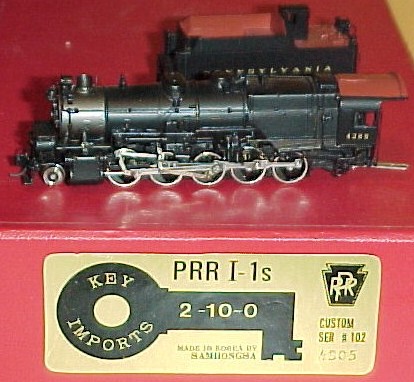



Introduced: 1992
Key's PRR 2-10-0 is a gorgeous looking model. And although "as delivered" it has a couple of minor performance problems, it does have the potential for being a fine runner (but more on that in a moment). As pictured above, these models are available with two different styles of tender.

The chassis is all metal, although it's also fairly minimalistic (with the shell providing most of the actual heft). The motor is an open-sided / straight-wound 5-poler. Right-rail pickup is provided by the right-side drivers and left-rail pickup is provided by the left-side tender wheels. Current is transferred from the tender to the locomotive via a stiff wire on the drawbar. The pilot truck is electrically neutral. The driveshaft consists of two short metal pieces joined by a plastic sleeve. The worm box and motor are mounted on a torque arm (with a leaf spring underneath, allowing for some up and down movement) The pilot coupler is a dummy (IE, non-operational) knuckle. There is no coupler on the tender (although a pocket and a screw are provided, so adding a Micro-Trains coupler looks to be a simple operation).

The center drivers are blind (IE, no flanges). All of the driver axles are mounted in bearing blocks that seat in cutouts in the frame. Only the center driverset is geared (with the remaining drivers being turned solely by the cranks). All gearing is metal. The wheels are low-profile, so no problems on Code-55 track. The drawbar has two holes - one for extreme close-coupling. The #4 drivers are equipped with traction tires. A non-TT driver set is included in the box should you wish to trade pulling power for additional pickup. A non-directional headlight is mounted inside the boiler (with wires then running back to the motor). A non-operational (IE, no lightbulb) back-up light is built into the tender. The shell includes cab interior detailing.
Overall performance is quite good. Mine runs smoothly and quietly for the most part, although it does have a very slight bind somewhere in the moving parts (and with the end result being a bit of herky-jerkiness at the extreme low end of the throttle). The top-end speed is a bit excessive, but not off the charts. Mine can haul thirty-some freight cars like they're not even there, so pulling power is strong.
On the down side, these models are limited to fairly wide radius curves. Although mine has no problems on 19"-radius curves, it will instantly derail when faced with 11"-radius curves or sharper. I don't know what the absolute minimum radius might be, but my guess would be around 15". Further down the down side, the drawbar current transfer scheme (with its single stiff wire) is a bit of a weak point. As always seems to be the case with that particular design, getting tender current to the motor can occasionally be a bit iffy (particularly when changing directions). Consequently, the occasional stall when operating at slow speeds does seem to be inevitable.
Were I interested in running one of these, I would first try replacing the straight wire with a "U-shaped" one (providing two points of contact on the tender post). A more ambitious solution would be to replace (or augment) the drawbar wire with an actual insulated mini- wire (running from the tender to the motor). Unfortunately, running wires between tender and loco is never pretty. Still, it would definitely provide for bulletproof electrical conductivity.

So overall, a great looking model that (with a bit of tweaking) has the potential to be a very good runner.
To remove the locomotive shell, first unscrew the two small screws on the back (cab) end. Next, loosen up the screw holding the pilot truck to the chassis and move the pilot truck out of the way - this will reveal the screw that holds the front of the shell to the chassis. Remove that and the shell should lift right off.
Grade: B (as long as you have wide curves)